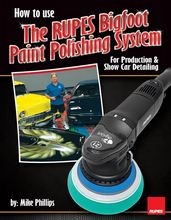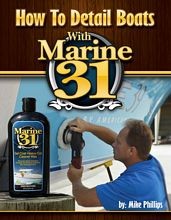Fight or Flight Method for Gaging Surface Temperature
The topic of heat comes up often when talking about using a rotary buffer to machine compound or polish paint. For decades now I read comments by people where they state heat is necessary when using a rotary buffer with a compound, or any other abrasive product that uses diminishing abrasives for abrading ability, in order to break the diminishing abrasives down. This is not accurate.
When buffing with a rotary buffer and any type of product that contains diminishing abrasive, including a compounds, paint cleaners, cleaner/polishes and even a cleaner/waxes, what`s necessary is pressure over time. Heat is just an unnecessary and unwanted byproduct of the process.
When using a rotary buffer for correction work for even a minute or longer, heat is unavoidable. The smaller the section your work the greater the risk of getting the paint hot. It`s normal and okay to get paint warm, (because there`s nothing you can do about it), but you don`t want to get paint hot and if you do get paint hot then you want to stop buffing in that section and let the paint cool down. So the question is,
How hot it too hot?
Or
What temperature range is consider warm and within a range that`s safe to work a rotary buffer?
I don`t know any specific temperature ranges recommended by any of the major paint companies to work within or extreme hot temperature ranges to avoid, so here`s the common sense approach anyone can use on-the-fly when buffing with a rotary buffer. This is a method I`ve been using since I started using a rotary buffer in the late 1980`s and that I`ve been teaching in any class that includes using a rotary buffer. It`s simple, yet effective and you don`t need to purchase any testing tools as you already have the tool you need built-in.
This method works off your hand`s sense of touch and your brain`s instincts to protect you. I call it the Fight or Flight Method for Gaging Surface Temperature. Not one of my better titles but descriptive to say the least.
The Fight or Flight Method for Gaging Surface Temperature
When using a rotary buffer, periodically check the temperature of the paint by placing the palm of your hand flat on top of a section you just finished buffing, like this,
If the paint feels warm, even close to hot, BUT it`s not so hot that you jerk your hand away, then it`s in a temperature range that`s safe to buff.
If you you place your hand on the paint and your Fight or Flight instinct takes over an you find yourself jerking your hand away from the surface at the speed of light, then the paint is too hot and you should stop buffing that section and allow the paint to cool down.
Kind of caveman but you get the idea. The bigger point is to check the surface temperature of the paint once in a while because you might surprise yourself at how hot you`re getting the paint. Because you`re in control of the rotary buffer you need pay attention to the surface temperature and this means pausing for a moment to feel the paint.
Different body panel materials, for example steel, aluminum, fiberglass, composite, will heat up at different rates and will either dissipate or hold heat at different rates, so it`s a good idea to check each time you work on a different car.
With testing, you can get a feel, (not pun intended), for how long you can buff an average size section and not be getting the paint too hot.

Results 1 to 4 of 4
-
12-14-2009, 05:18 PM #1
Fight or Flight Method for Gauging Surface Temperature
Mike Phillips
Host - Competition Ready on Velocity Channel
Director of Training Autogeek & Marine 31
Competition Ready Facebook Page
Mike Phillips Facebook Page
Twitter
Instagram
Click on a book to get your own copy.







-
12-15-2009, 08:22 AM #2
Re: Fight or Flight Method for Gauging Surface Temperature
Mike - thank you for sharing your knowledge. I will put that into practice immediately.
-
12-15-2009, 09:17 PM #3
Re: Fight or Flight Method for Gauging Surface Temperature
buff the car wet and you won`t have those heat issues.
-
08-26-2010, 10:16 AM #4
 Re: Fight or Flight Method for Gauging Surface Temperature
Re: Fight or Flight Method for Gauging Surface Temperature
Great thing to point out Mike. Especially with foam pads.
Thread Information
Users Browsing this Thread
There are currently 1 users browsing this thread. (0 members and 1 guests)
Similar Threads
-
Actual surface temperature while buffing/polishing
By Jean-Claude in forum Machine Polishing & SandingReplies: 29Last Post: 12-28-2008, 04:30 AM -
Flight 93????
By Beemerboy in forum Hot TubReplies: 25Last Post: 05-01-2006, 08:19 AM -
Paint Surface Temperature Discussion
By imported_zenhog in forum Car DetailingReplies: 15Last Post: 08-27-2003, 09:33 PM







 Reply With Quote
Reply With Quote

Bookmarks